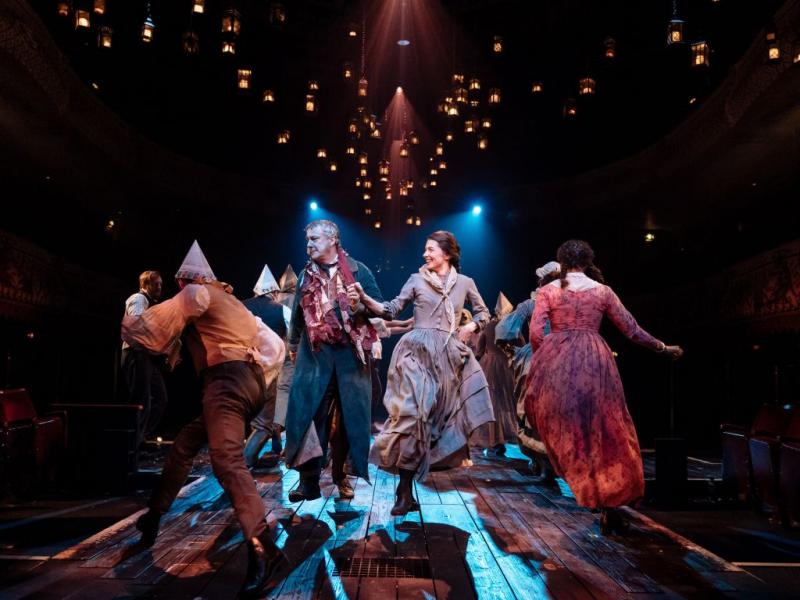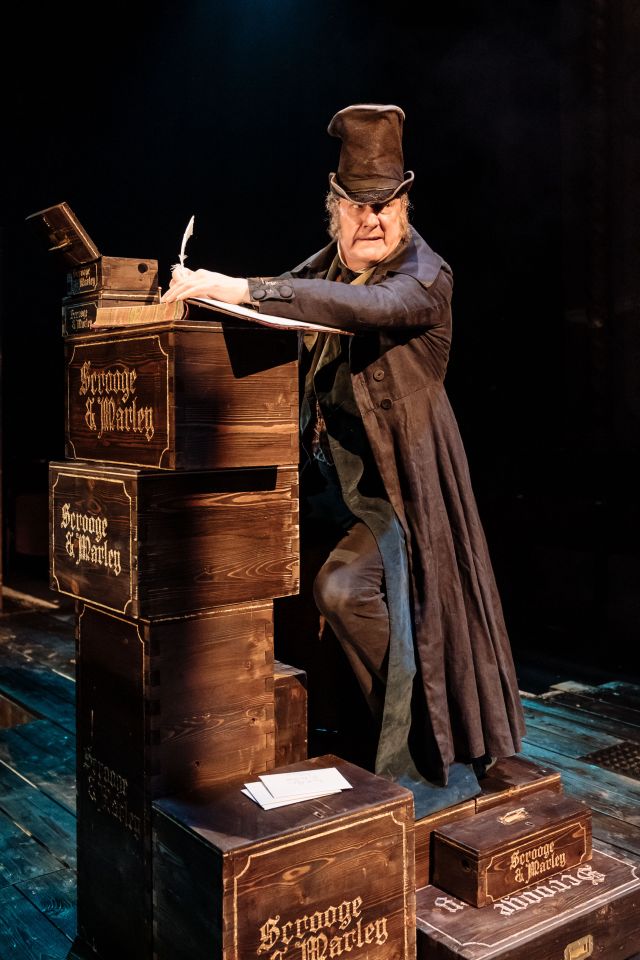A Christmas Carol, Old Vic review - Dickens adaptation returns, depth and mince pies intact | reviews, news & interviews
A Christmas Carol, Old Vic review - Dickens adaptation returns, depth and mince pies intact
A Christmas Carol, Old Vic review - Dickens adaptation returns, depth and mince pies intact
Last year's festive-season hit, re-cast, continues to enchant

The Old Vic's revival of its successful Christmas Carol first seen this time last year had me at the mince pies: they were served before curtain up by a Bob Cratchit figure while we admired the shoal of Victorian lanterns lighting the way over a cross-shaped stage that cuts the audience into quarters.
Matthew Warchus's production has all the bells and whistles, particularly the bells. The hand bells rung so tunefully by the cast are a Yuletide highlight, along with a sweet score of melodious interwoven carols, with the cast chiming in. I do have one reservation: let's face it, Scrooge's ordeal-by-ghost is a thoroughly pagan story, and to have him woken from sleep on Christmas morning with a hail of redemption's happy dawn, when Jesus hardly figures in this particular resurrection, makes for an odd juxtaposition. This is a story of the spirit of Christmas but not a holy one.
 A Christmas Carol carries that same slight sense of seasonal dread as The Nutcracker: that the adults are prepared to be bored by an oft-told story but hope the children won't be. Not so in Jack Thorne's version, which starred Rhys Ifans as Scrooge last year and Stephen Tompkinson (pictured right) in that same role now. There's been enough tinkering with Dickens's text to keep the curiosity up. Building a more important relationship with Scrooge's bullying father, it allows Tompkinson to impart modern shading to the role. No simple miser, this Scrooge comes with emotional baggage, and the Ghost of Christmas Past puts him through some heavy childhood immersion therapy. As he goes happily mad in the closing scenes, there's a hint that depressive miserableness might give way to a full-blown manic episode.
A Christmas Carol carries that same slight sense of seasonal dread as The Nutcracker: that the adults are prepared to be bored by an oft-told story but hope the children won't be. Not so in Jack Thorne's version, which starred Rhys Ifans as Scrooge last year and Stephen Tompkinson (pictured right) in that same role now. There's been enough tinkering with Dickens's text to keep the curiosity up. Building a more important relationship with Scrooge's bullying father, it allows Tompkinson to impart modern shading to the role. No simple miser, this Scrooge comes with emotional baggage, and the Ghost of Christmas Past puts him through some heavy childhood immersion therapy. As he goes happily mad in the closing scenes, there's a hint that depressive miserableness might give way to a full-blown manic episode.
With a fine felty face under a fine felt hat, Tompkinson has got the punch to hold the thing together despite occasionally ropey scripting. There's a lot to tell in a tight two hours, and poor old Scrooge barely has time to lie down before Morley comes knocking.
The production begs the question as to when Scrooge begins to turn, and why? With the help of Marley's ghost, might there be the suspicion that calculating old Scrooge sees the writing on the wall and pulls off a change of tune just in time? This version points toward a genuine change of heart through trauma relived and faced down.
We'll all have a baseline Scrooge by way of comparison: mine is the musical version, with Albert Finney. Tompkinson, for his part, quarrels nicely with the phantoms, who are all women (just like God but a bit sterner) and who take him on a tour of a land full of poverty and wretchedness, aka modern Britain. There's a moving encounter between the young Scrooge and the old, though a bit of puzzlement as to why Fezziwig should be an undertaker. Peter Caulfield lights up every scene as Cratchit, Eugene McCoy is suitably tousle-haired and well-intentioned as Fred, and Lenny Rush's Tiny Tim turns in all the dewy-eyed moments.
A good meaty programme fills out the interval – the real thing with a sharp essay on the novella by Dickens's great great great granddaughter, a well-honed charity appeal, and nice pics. The mince pies, by the way, were moreish to a fault: the production comes generously supported by Waitrose.
- A Christmas Carol at the Old Vic until 19 January
- Read more theatre reviews on theartsdesk
The future of Arts Journalism
You can stop theartsdesk.com closing!
We urgently need financing to survive. Our fundraising drive has thus far raised £49,000 but we need to reach £100,000 or we will be forced to close. Please contribute here: https://gofund.me/c3f6033d
And if you can forward this information to anyone who might assist, we’d be grateful.

Subscribe to theartsdesk.com
Thank you for continuing to read our work on theartsdesk.com. For unlimited access to every article in its entirety, including our archive of more than 15,000 pieces, we're asking for £5 per month or £40 per year. We feel it's a very good deal, and hope you do too.
To take a subscription now simply click here.
And if you're looking for that extra gift for a friend or family member, why not treat them to a theartsdesk.com gift subscription?
more Theatre
 Troilus and Cressida, Globe Theatre review - a 'problem play' with added problems
Raucous and carnivalesque, but also ugly and incomprehensible
Troilus and Cressida, Globe Theatre review - a 'problem play' with added problems
Raucous and carnivalesque, but also ugly and incomprehensible
 Clarkston, Trafalgar Theatre review - two lads on a road to nowhere
Netflix star, Joe Locke, is the selling point of a production that needs one
Clarkston, Trafalgar Theatre review - two lads on a road to nowhere
Netflix star, Joe Locke, is the selling point of a production that needs one
 Ghost Stories, Peacock Theatre review - spirited staging but short on scares
Impressive spectacle saves an ageing show in an unsuitable venue
Ghost Stories, Peacock Theatre review - spirited staging but short on scares
Impressive spectacle saves an ageing show in an unsuitable venue
 Hamlet, National Theatre review - turning tragedy to comedy is no joke
Hiran Abeyeskera’s childlike prince falls flat in a mixed production
Hamlet, National Theatre review - turning tragedy to comedy is no joke
Hiran Abeyeskera’s childlike prince falls flat in a mixed production
 Rohtko, Barbican review - postmodern meditation on fake and authentic art is less than the sum of its parts
Łukasz Twarkowski's production dazzles without illuminating
Rohtko, Barbican review - postmodern meditation on fake and authentic art is less than the sum of its parts
Łukasz Twarkowski's production dazzles without illuminating
 Lee, Park Theatre review - Lee Krasner looks back on her life as an artist
Informative and interesting, the play's format limits its potential
Lee, Park Theatre review - Lee Krasner looks back on her life as an artist
Informative and interesting, the play's format limits its potential
 Measure for Measure, RSC, Stratford review - 'problem play' has no problem with relevance
Shakespeare, in this adaptation, is at his most perceptive
Measure for Measure, RSC, Stratford review - 'problem play' has no problem with relevance
Shakespeare, in this adaptation, is at his most perceptive
 The Importance of Being Earnest, Noël Coward Theatre review - dazzling and delightful queer fest
West End transfer of National Theatre hit stars Stephen Fry and Olly Alexander
The Importance of Being Earnest, Noël Coward Theatre review - dazzling and delightful queer fest
West End transfer of National Theatre hit stars Stephen Fry and Olly Alexander
 Get Down Tonight, Charing Cross Theatre review - glitz and hits from the 70s
If you love the songs of KC and the Sunshine Band, Please Do Go!
Get Down Tonight, Charing Cross Theatre review - glitz and hits from the 70s
If you love the songs of KC and the Sunshine Band, Please Do Go!
 Punch, Apollo Theatre review - powerful play about the strength of redemption
James Graham's play transfixes the audience at every stage
Punch, Apollo Theatre review - powerful play about the strength of redemption
James Graham's play transfixes the audience at every stage
 The Billionaire Inside Your Head, Hampstead Theatre review - a map of a man with OCD
Will Lord's promising debut burdens a fine cast with too much dialogue
The Billionaire Inside Your Head, Hampstead Theatre review - a map of a man with OCD
Will Lord's promising debut burdens a fine cast with too much dialogue

Add comment